 Easy Method to Growing Cryptocoryne Emersed
Easy Method to Growing Cryptocoryne Emersed
A great amount of aquarium plants we see online and in the local fish store are grown emersed. Emersed grown plants are easier to ship. Since they are not underwater there is little need to try to combat algae or run filters. Emersed is just an all around easier method to growing aquarium plants.
Growing cryptocoryne emersed isn’t a difficult task. Of course some are more difficult to maintain and propagate than others but with a little help you can be growing cryptocorynes in a small space. It can be as simple or as dedicated as you want to commit to. Whether you are on a budget or have some tax return coming your way there is a scale suitable to fit your needs and wishes.
Cryptocoryne Grows Emersed Naturally
Many don’t realize that often cryptocoryne grows above the water level at least in part. Some more so than others. Some like C. striolata grabs hold to whatever it can to hang onto in the current, whether it be a tree root or some rocks. Others prefer the riparian area just above the water line. What they share in common though is that they can almost all be grown emersed more quickly and easily than submerged in water.
Cryptocorynes are rhizome feeders and create an elaborate root structure. Perhaps in part to hang on in the event of high water which brings fast water currents, but also to feed the plant. Cryptocorynes are root feeders which bring nutrients to the rhizome and then on to the other parts of the plant. They still absorb nutrients from the water column with the leaves, but they more heavily feed using the roots.
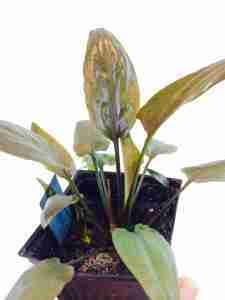 In fact, the rhizome is part of the cryptocorynes saving grace. In the even that their environment under water suddenly becomes dry and arid (or vice versa) they will do what crypts tend to do when faced with adversity. They melt. Instead of spending too much effort waiting for leaves to hopefully recover the cryptocoryne simply sloughs off the old leaves and begins a new form of growth. This saves the plant valuable resources that the rhizome has stored up. When transitioning, it is always easier to move a cryptocoryne from emersed growth into the submerged aquarium.
In fact, the rhizome is part of the cryptocorynes saving grace. In the even that their environment under water suddenly becomes dry and arid (or vice versa) they will do what crypts tend to do when faced with adversity. They melt. Instead of spending too much effort waiting for leaves to hopefully recover the cryptocoryne simply sloughs off the old leaves and begins a new form of growth. This saves the plant valuable resources that the rhizome has stored up. When transitioning, it is always easier to move a cryptocoryne from emersed growth into the submerged aquarium.
Since the cryptocoryne is a heavier root feeder it does well growing in tubs and containers emersed. The substrate used to grow the plants can be supplemented with a slow release balanced fertilizer. For the first few weeks to a month there’s little more to do than keep the substrate nice and moist so it doesn’t dry out.
Suitable Substrate for Cryptocorynes
Most cryptocorynes can be grown simply in potting soil. One of my blackwater mixes uses a 1:1 ratio of coarse river sand and potting mix. For some of the clearwater species I use a 2:1 sand/gravel and potting mix. I either make my own potting mix or buy Miracle Gro with the slow release fertilizer in it. If I make my own potting mix I add some slow release granules in a balanced 10-10-10 formula. There are clear water streams and there are blackwater streams where cryptocorynes are found and I mix my substrate accordingly to better suit their growing requirements.
In keeping clearwater plants like striolata, they often do better with less organics and more of the inert material in the substrate like sand and gravel than plants from black water streams. Blackwater cryptocoryne do better with more organics like peat moss, coconut coir, compost, leaf litter, or fine pine bark. Turface is a good inert ingredient to help lighten potting mix if you can find it at your landscape supplier. Most will be fine with quality bagged potting soil (with or without slow release fertilizier), coarse sand, fine gravel, coconut coir, peat moss, sawdust, or a multitude of other filler material.
 Each species has its own preference for PH and additives like sphagnum peat moss or dolomite will help the plant. Cryptocoryne hudoroi benefits from some calcium to help keep the substrate from becoming too acidic and it will be happy with little organic matter. Pelleted dolomite mixed into some of the clearwater species substrate suits their requirements and helps them grow.
Each species has its own preference for PH and additives like sphagnum peat moss or dolomite will help the plant. Cryptocoryne hudoroi benefits from some calcium to help keep the substrate from becoming too acidic and it will be happy with little organic matter. Pelleted dolomite mixed into some of the clearwater species substrate suits their requirements and helps them grow.
A little research about where the plant came from can give you some clues for creating your perfect substrate for thriving plants. Find out what the conditions are in the natural range and simulate those the best you can. Each time to repot make small changes to your media and pay attention to notes you take on growth patterns and health. After several repottings you will understand what is best for east species and your plants will be thriving.
Container Types to Grow Cryptocoryne
The containers you use to propagate cryptocoryne in are not all that important. Either grow them in a tray or keep individual pots in a tray. Barebottom aquariums work well but can be costly. Clear plastic storage containers also work quite well but UV from lighting or the sun will make them brittle in a season most of the time. Hydroponic rockwool in 2 inch net pots are also great especially if you plant to supply plants to your local fish store for credit.
I prefer 1020 nursery trays (10 inches wide and 20 inches long) whether they have cells or are just an empty tray. Whatever container method you prefer to use make sure that it holds in humidity and that you can regulate the humidity. The 1020 nursery trays have several kinds of clear plastic humidity domes, most common being a 2 inch tall and a 7 inch tall. The humidity domes stand up to UV fairly well but can break with rough handling. If using a shelving rack to grow indoors the 1020 trays can certainly make a clean and tidy growing area.
There are a multitude of cell trays that fit into empty 1020 trays. The ten by twenty trays come in various thicknesses and also draining or non draining. It is pretty easy to grow cryptocorynes in these cells using rock wool. Buy cubes or tear balls of rockwool to fit each cell (they come from 72 to 18 cells as most common). Fold the rockwool around the roots of the crypto and press the rockwool into the cell of the tray. This is the easiest and cleanest methods of growing indoors. Simply use a good fertilizer in the water layer on the bottom of the trays.
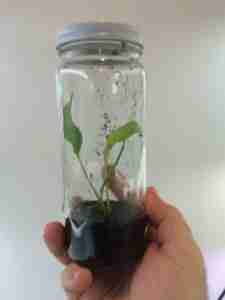 Glass jars in various sizes are great vessels to grow cryptocorynes in as well. Often when I receive a new or hard to get crypto I will mix some substrate and pour about an inch and a half of media into the bottom. Using forceps I plant the crypto in the jar neatly and add some water. I finish the jar off with a label of what it is and any information I may need to retain.
Glass jars in various sizes are great vessels to grow cryptocorynes in as well. Often when I receive a new or hard to get crypto I will mix some substrate and pour about an inch and a half of media into the bottom. Using forceps I plant the crypto in the jar neatly and add some water. I finish the jar off with a label of what it is and any information I may need to retain.
Smaller containers are easier to work with than a full 10 inch by 20 inch nursery tray for most people. Small plastic grocery store vegetable containers or any other containers you can scavenge will work. Just remember that all the containers have to have their water levels checked and maintained. This is why lots of smaller vessels not in a bottom watering tray takes more time. Small containers that drain can be sat into a bottom watering tray for convenience. When it’s time it’s easy to add fertilizer and water to all the containers instead of one at a time.
Bottom Watering Trays
Regardless of which method you use to hold your plants they must have water. If you are using a draining container they can be sat in a bottom watering tray. The trays only job is to hold water so that it can wick up into the substrate and keep the plant sufficiently wet. This method offers the most convenience. It makes for fast water changes that should be done at least twice a month, preferably more often if algae or bad odors occur.
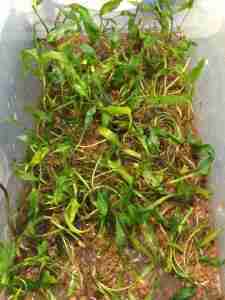 The water should only be deep enough to act as a reservoir. Potting soil tends to hold water longer than rockwool so water doesn’t seem to evaporate as quickly. It may be necessary to add water every day, every other day, or maybe just once a week or two depending on the volume and humidity of the growing area.
The water should only be deep enough to act as a reservoir. Potting soil tends to hold water longer than rockwool so water doesn’t seem to evaporate as quickly. It may be necessary to add water every day, every other day, or maybe just once a week or two depending on the volume and humidity of the growing area.
Algae will be waiting to grow at any moment because of the nutrients in the potting mix and or the water column in the bottom of the trays. To combat this water shouldn’t be allowed over the top of the substrate. If algae does occur make water changes and lower the water volume incrementally. If algae does get bad it may be necessary to turn down the lighting. Generally speaking though algae is a rare occurrence in the emersed system.
Lighting for Emersed Propagation
Plants use light for photosynthesis and without it you can expect slow growth if any. Luckily the cheap hardware store fluorescent tubes work great for growing emersed plants. The color isn’t terribly important but I try to use 6500K bulbs. Anywhere from 4500 to 6700 Kelvin is sufficient. Even lower Kelvin colored bulbs in the yellow range will work but brighter colored 6500K bulbs makes for a happier plant room environment.
Fluorescent tubes go well in shop light fixtures, and they are cheap and easy. Hang the shoplights just a couple inches over the plants or the lid of the bin. On most shelving I have set up I use two shoplights for each level for a total of 4 fluorescent tubes. If you need more or less light you can move the lighting up or down. Fluorescent tubes don’t put out a lot of heat but they will burn the tips of your plants if they are too close or touch. I don’t use any coverings over the fluorescent tubes as it lowers the output of lighting the plants receive.
Fertilizing Your Emersed Grown Cryptocoryne
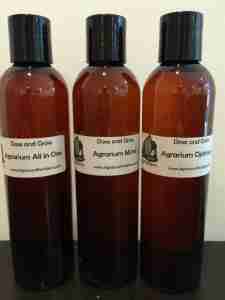 Nutrients are an essential part of plant growth and development. Your plants need it to grow leaves, roots, and inflorescence. Emersed grown plants are much easier to manage nutrients for than in a submerged aquarium.
Nutrients are an essential part of plant growth and development. Your plants need it to grow leaves, roots, and inflorescence. Emersed grown plants are much easier to manage nutrients for than in a submerged aquarium.
Potting mix can have a slow release fertilizer like Osmocote added to the mix or sprinkled lightly on top of larger pots and trays. A little goes a long way. A few pinches on top of a 1020 tray spread out very evenly every couple weeks will suffice. You will get accustomed to seeing what your plants need after a couple of months. Osmocote or similar slow release fertilizer can also be added to the water column directly.
Dry fertilizers used for the planted tank can also be used. There are a few articles on making Agrarium fertilizer project Biotope One did that you can use as a guide. Since it’s formulated for 1ml per gallon it’s easier to dose into containers. It is best to start in small volumes to avoid burning the plants, especially nitrogen, than to dose too much and kill your plants.
One method I gleaned from food and ornamental crops is the use of a foliar spray. Foliar sprays are used to give micronutrients through application to the leaf. Leaves can uptake many nutrients and micronutrients help the plants when spritzed a couple times a week. Red plants especially benefit from the iron. The All in One Agrarium formula diluted to a fourth worked well. It is applied using a spray atomizer bottle and the plants are sprayed a few times a week. Enough to moisten the leaves is good.
Separating Method for Propagation
When starting out with a single hard to get plant I often use a glass jar with a lid. Patiently I let the plant grow and mature, sending up shoots from its adventurous roots. When there are more new plants I split them up again and put some into a plastic tray. Shortly the plastic tray will fill with new plants.
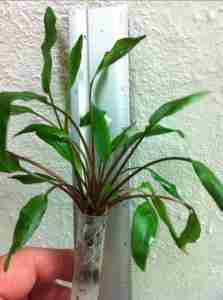 Carefully pulling them apart at the roots is the best way to split up a thriving colony of the aquatic aroids. Once separated it is best to group them into clusters of the same size. That way they all mature together at the same rate and are ready to use or trade off at the same time. This is much easier than having to dig through several containers when you need a certain amount of plants.
Carefully pulling them apart at the roots is the best way to split up a thriving colony of the aquatic aroids. Once separated it is best to group them into clusters of the same size. That way they all mature together at the same rate and are ready to use or trade off at the same time. This is much easier than having to dig through several containers when you need a certain amount of plants.
The biggest and best plants usually send out the most plantlets. It is best to use these plants to grow more plantlets instead of trading them off. When you have enough containers to produce the plants you need you can start trading off mother plants. Until then use them to grow plantlets and trade off the up and coming plants. Don’t wait too long to separate plants or the root mass could become root bound and prove difficult to separate the plants.
Once the plants are all separated and arranged in groups according to size I most often will use a pair of scissors and cut the roots all to one size. This helps keep the plants growing at the same rate roughly. Two to three inches is usually good for most plants smaller than mother plants. The huge mother plants I usually get another extra inch of roots left on them. Trimming the roots does not harm a healthy plant and it appears that it helps stimulate the plant send up shoots to begin new plants.
Emersed Aquatic Plants Aren’t That Difficult
With minimal monetary investment and relatively little other resources and time you can produce a substantial amount of cryptocorynes in a small space. Some keep their growing setups under their beds, in closets, or spare corners of a room. Growing and sharing plants can help you obtain new plants by trading your excess. It also can reduce collection in the wild in some instances. Many expensive plants are only expensive because there is more demand than there is supply. If more people propagated more plants the hobby would benefit along with the hobbyists. Trading would be easier and growing your collection will be easier if you grow your own excess of plants. Give it a try and reap the benefits of having a supply of plants on hand.
 Biotope One A Study of Flora and Fauna
Biotope One A Study of Flora and Fauna 


